The U.S. Department of Justice has published new median, gross annual income data for use in bankruptcy cases filed on or after April 1, 2024. For Minnesota residents, the figures have increased, making it more likely that you will qualify for Chapter 7 relief.
Here is how much the median amounts will increase in Minnesota from numbers used in cases filed after April 1, 2023:
One person household: $72,319
Two person household: $93,855
Three person household: $117,426
Four person household: $141,903
The increase for additional household members above is $9,900. NOTE: these figures can and likely will change in the future so please make sure you are relying on the most current information when attempting to calculate means test eligibility.
A reminder: the median income amounts are only part of the analysis for determining whether you qualify for Chapter 7 relief. Calculating the amount is based primarily on your gross income for the six months prior to your month of filing. But you can sometimes be over the amount and still qualify after completing the full, long-form means test. How to count household income can be tricky as well, depending on sources (social security benefits do not count, for instance) along with the amounts that are contributed by other household members.
As always, consultation with a qualified, experienced bankruptcy attorney is critical. But if you're struggling with debts, starting next month it may be a little easier for you to qualify for relief.


